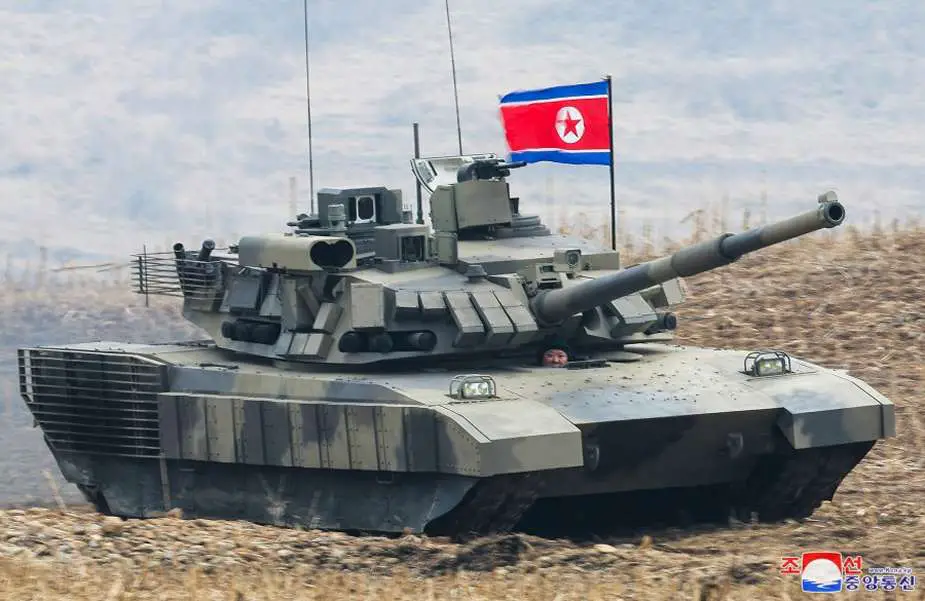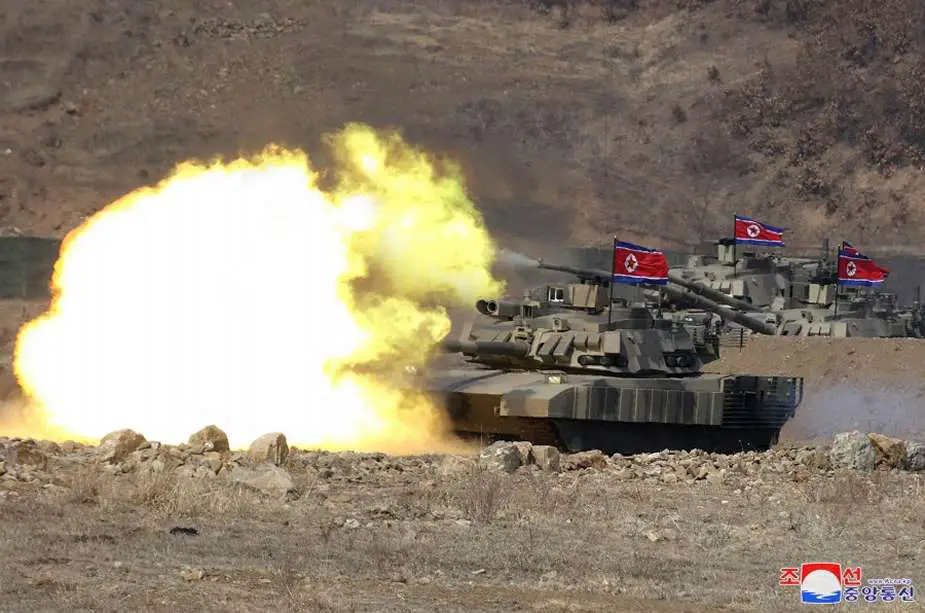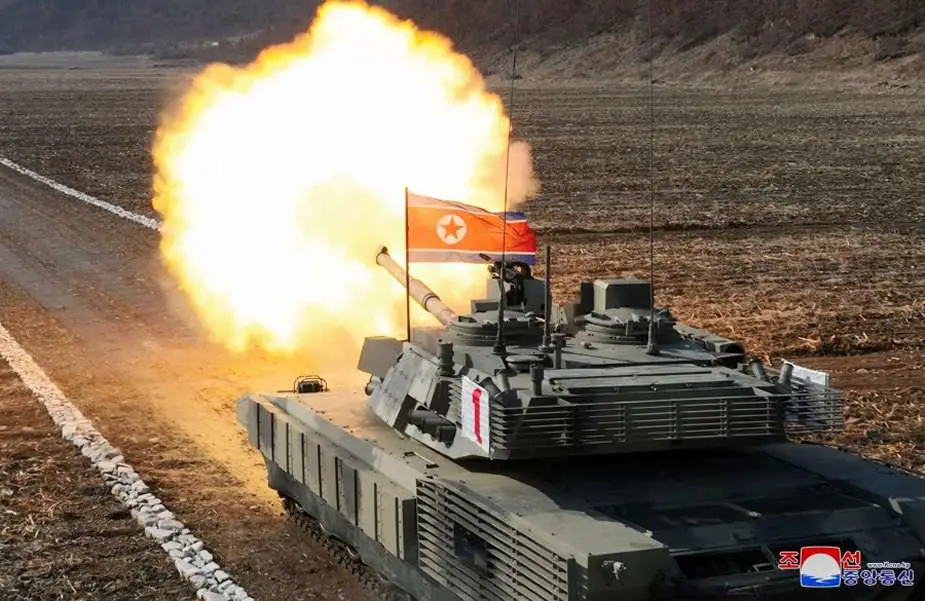Breaking news
Discover New M2024 North Korea Tank Using Technologies of US M1A2 Abrams & Russian T-14 Armata.
On March 14, 2024, North Korea unveiled the M2024 main battle tank, an update from the earlier M2020 model, during combined exercises between tank and mechanized units of the North Korean Army, amid ongoing joint military drills between South Korea and the United States. The M2024 main battle tank incorporates several features aimed at enhancing its operational capabilities while also raising questions regarding North Korea's tank design principles.
Follow Army Recognition on Google News at this link

North Korea now appears to have the capacity to produce and develop its own Main Battle Tanks. (Picture source: KCNA)
Currently, the new North Korean Main has no official name, therefore leaving no choice but to use a generic name. The first version of this tank, the M2020, was first revealed in October 2020 during a military parade marking the 75th anniversary of the Worker's Party of Korea (WPK). As reported by Army Recognition on August 10, 2023, it appears that an accelerated production of the new North Korean main battle tank has recently been observed. The Kusong tank plant in North Korea has undergone significant renovations, doubling its size with a new manufacturing hall and additional production structures between October 2022 and June 2023, a fact that may also explain why the M2020 seems to be an exhibition model compared with the M2024, which is better thought out in terms of possible deployment in combat.
Starting with the slightly redesigned turret, which seems very similar to the American M1A2 Abrams, the M2024 is equipped with 21 explosive reactive armor (ERA) blocks at the front, intended to counteract the effects of incoming projectiles. Alongside these, there are six smoke grenade launchers designed to create a smokescreen, potentially obscuring the tank from enemy view. Additionally, there is a noticeable hole on the left side of the gun, speculated to be for an observation or vision device, as the alternative function as a casing evacuator seems unlikely due to the potential hazard of ejecting casings in front of the tank. The turret also includes two rectangular boxes that resemble components of an active protection system (APS), which are typically used to intercept incoming projectiles before they reach the vehicle.
The right side of the turret is fitted with a launcher for two anti-tank guided missiles (ATGMs), capable of pivoting like the TOW launcher found on the American Bradley, indicating an ability to engage different types of targets with what observers believe to be Bulsae-3 missiles, a copy of the Russian-made Kornet anti-tank missile. Each side of the turret also features approximately 12 ERA components and two blocks of three smoke grenade launchers, with another set of rectangular boxes suggestive of APS units, maybe the laser alarm receiver radars.
The top of the turret is outfitted with meteorological equipment, presumably an anemometer, and on the left side, what may look like a cross-wind sensor, alongside two antennas, presumed for communication purposes, and two observation systems, likely for improved battlefield surveillance. We can also see what looks like a commander’s panoramic sight mounted on the right side of the turret roof, a gunner sight just below, and another fixed episcope on the right of the commander’s cupola. The turret is completed with two hatches, possible blowout panels at the rear for safety measures, and a storage basket.
According to sugar_wsbn, the circular element observed on the left side of the M-2020 tank's turret top might serve as a manual shell casing ejection hatch, if we assume that the tank's layout positions the loader on the left side of the turret, with the captain and gunner on the right, and the driver in the center of the chassis. Given the placement and orientation of this element, if intended as a shell ejection hatch for a manually loaded 125mm smoothbore gun, raises questions about the efficiency and safety of such a design, especially under combat conditions.

The M2024 main battle tank incorporates several features aimed at enhancing its operational capabilities compared to the previous M2020 MBT. (Picture source: KCNA)
The M2024 tank is said to be equipped with an engine with a minimum power output of 1,200 hp allowing for a maximum speed of 65 km/h, for an estimated weight ranging from 50 to 55 tons. Additionally, there are assumptions that the M-2024 may include modern fire control and communication systems. According to available information, it seems that the turret could be made of welded construction and is also fitted with composite spaced armor.
According to our first analysis, the main armament is very similar to a Soviet-made 125mm and could be a derivative of the Soviet 2A46 smoothbore gun able to fire Armor-Piercing Fin-Stabilized Discarding Sabot (APFSDS), High-Explosive Anti-Tank (HEAT) and High-Explosive Fragmentation (HEF) projectiles. As the Russian tank, it can be coupled to an automatic loading system. Visually, the main gun is equipped with a fume extractor and an aiming or sighting system consisting of three components, including a laser range finder on the upper part of the gun.
Like the M2020 tank, the second armament of the M2024 tank includes one 7.62mm coaxial machine gun mounted to the left of the main armament. A manually or remotely operated weapon station is mounted at the front of the hatch located on the left side of the turret roof which is armed with a 30mm automatic grenade launcher.
Each side of the hull, visually similar to the Russian T-14 Armata tank, now features ten ERA blocks, and two steps for the crew at either end of the row of ERA blocks. The front of the hull includes two periscopes under the gun, enhancing the driver's field of vision. At the rear of the hull, there are two large grilles for evacuating engine heat, and on the left side of the hull, there is a modification for the vehicle’s exhaust system, which required a cutout in the hull's wire cage armor. It could be that the protrusions seen on the front of the tank's hull are simply rivets, with all the potential risks that implies.
The suspension system, which seems to be based on Soviet design tanks, on each side still consists of seven road wheels with the drive sprocket at the rear and the idler at the front. The upper part of the suspension is covered by armor plates while the lower part is protected by polymer or rubber skirts that cover most of the road wheels. The M2024 protection also includes wire cage armor on the rear of the turret and the sides, similar to some of the latest Russian tanks, providing added protection, particularly against anti-tank infantry weapons. However, the rear of the hull, notably around the engine area, does not feature this type of armor, which may indicate a potential vulnerability.

The rear of the hull, notably around the engine area, does not feature any wire cage armor, which may indicate a potential vulnerability. (Picture source: KCNA)























